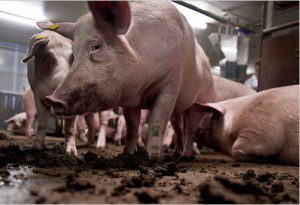

Porcine epidemic diarrhea virus is a member of the coronavirus family, which also includes the SARS and MERS coronaviruses (CoV). Before 2013 the virus had not been isolated in North America. It was detected on a farm in Iowa in May and subsequently spread to 22 states. It is estimated that between 1-4 million pigs have died of the disease in the US. Recently the virus was found on a Canadian pig farm in Middlesex County, where it most likely arrived from the US.
PEDV can infect pigs of all ages, but is most serious in nursing pigs in which the clinical symptoms are the most severe. The disease is characterized by acute vomiting and watery diarrhea which in nursing pigs leads to dehydration and frequently death. There is no treatment for the disease other than rehydration; no antiviral drugs are available, but a vaccine was developed in 2013. The virus does not infect humans.
Sequence analysis of genomes from three US isolates of PEDV indicate that they are most closely related to a virus isolated in 2012 in Anhui, China. These data suggest, but do not prove, that the US PEDV originated from China. How the virus might have arrived from that country is a matter of speculation. The virus is believed to move from farm to farm on trucks that are used to carry pigs, as well as on contaminated boots and clothing. Many farms observe strict biosecurity procedures in which trucks are properly washed, disinfected, and heated to inactivate the virus. However these procedures cost money and take time, and may be bypassed in some cases. If older pigs are asymptomatically infected, they might be transported to other farms and spread the virus. Once in a farm, stopping spread of the virus is difficult: it is spread by fecal-oral contamination.
The coronavirus family is divided into four genera: Alphacoronavirus, Betacoronavirus, Gammacoronavirus and Deltacoronavirus. Several human coronaviruses that cause common cold-like illness, as well as PEDV, are alphacoronaviruses. SARS-CoV and MERS-CoV are betacoronaviruses. Viruses in the alphacoronavirus and betacoronavirus genera are believed to have originated from bats, while birds might have been the origin of viruses in the other two genera. Analysis of the PEDV genome sequence indicate that the 5′-untranslated region is similar to that of a bat coronavirus. Based on this information it has been suggested that PEDV originated from a cross-species transfer of a bat alphacoronavirus into pigs.
National Hog Farmer is not usually on my reading list, but it has a good summary of porcine epidemic diarrhea.

Why are birds and bats (more so, I think) so often implicated as being sources for viruses? What is special about them that makes them good hosts and transmission vectors?
Good questions, with few solid answers. For both species, huge mobility certainly is a factor, plus the great numbers – bats are 20% of mammals on Earth. Bats also interact with each other (e.g. in caves). Finally, the bat immune system, to keep down the inflammation associated with flight, seems to have evolved features that might help dealing with viruses. See TWiV 268 for our discussion of the bat genome in this context.